Child Malnutrition: Examining Causes, Impacts, and Solutions Report
VerifiedAdded on 2020/04/21
|15
|3935
|43
Report
AI Summary
This report provides a comprehensive overview of child malnutrition, a significant global health problem affecting millions of children worldwide. It explores various factors contributing to malnutrition, including poverty, food insecurity, maternal undernutrition, gender bias, and environmental factors like drought and soil erosion. The report highlights the severe consequences of malnutrition, such as increased child mortality, stunted growth, delayed mental development, and increased susceptibility to infectious diseases. It discusses the link between malnutrition and conditions like intrauterine growth restriction (IUGR) and micronutrient deficiencies. The report also examines the impact of socioeconomic determinants, like domestic violence and maternal education, on child health. Additionally, it reviews treatment strategies like RUTF and antibiotic use, while also considering the limitations and potential harms associated with these interventions. The report emphasizes the importance of addressing the root causes of malnutrition through multifaceted approaches, including improving socioeconomic conditions, promoting maternal education, and implementing targeted interventions to improve child health outcomes.
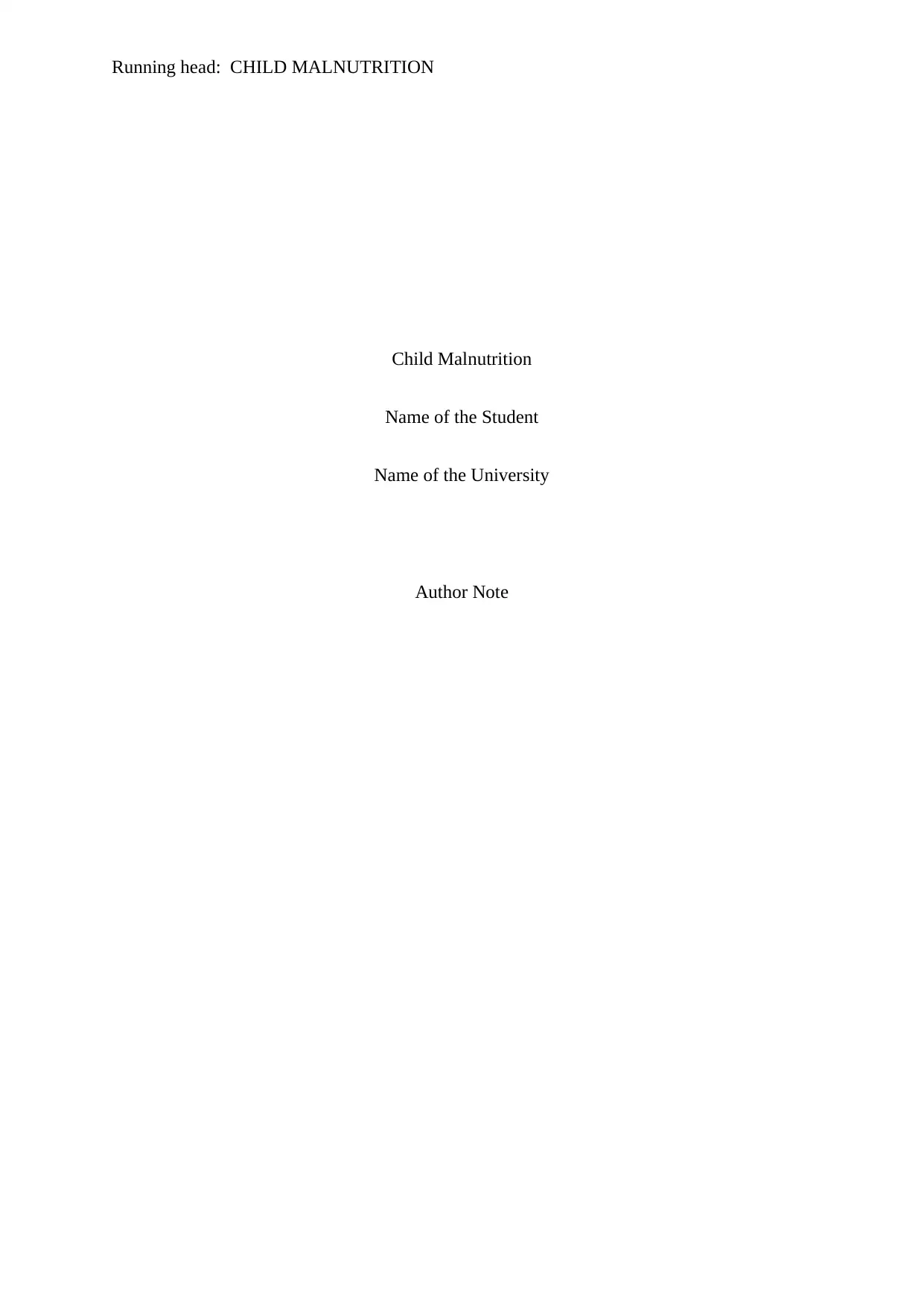
Running head: CHILD MALNUTRITION
Child Malnutrition
Name of the Student
Name of the University
Author Note
Child Malnutrition
Name of the Student
Name of the University
Author Note
Paraphrase This Document
Need a fresh take? Get an instant paraphrase of this document with our AI Paraphraser
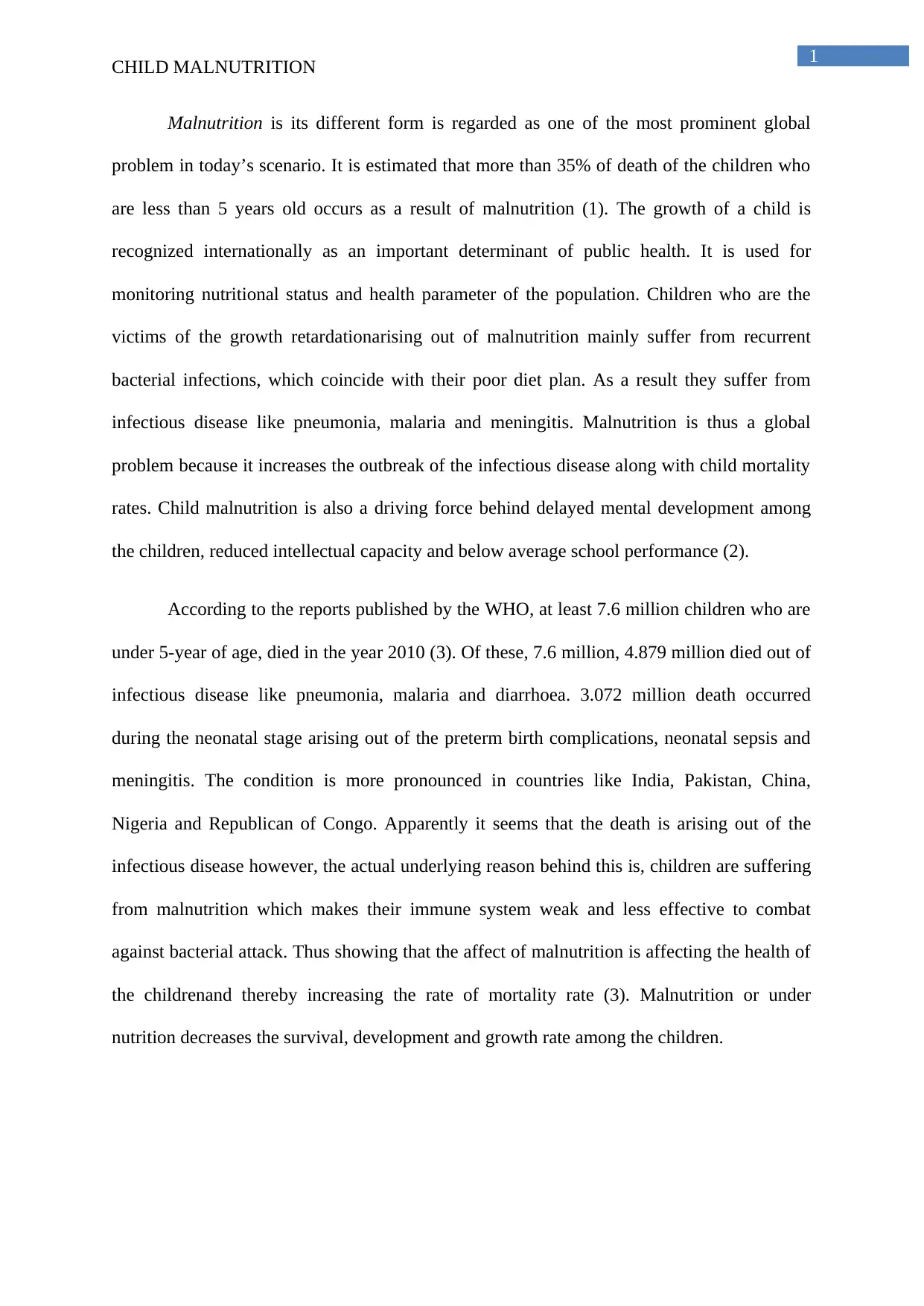
1
CHILD MALNUTRITION
Malnutrition is its different form is regarded as one of the most prominent global
problem in today’s scenario. It is estimated that more than 35% of death of the children who
are less than 5 years old occurs as a result of malnutrition (1). The growth of a child is
recognized internationally as an important determinant of public health. It is used for
monitoring nutritional status and health parameter of the population. Children who are the
victims of the growth retardationarising out of malnutrition mainly suffer from recurrent
bacterial infections, which coincide with their poor diet plan. As a result they suffer from
infectious disease like pneumonia, malaria and meningitis. Malnutrition is thus a global
problem because it increases the outbreak of the infectious disease along with child mortality
rates. Child malnutrition is also a driving force behind delayed mental development among
the children, reduced intellectual capacity and below average school performance (2).
According to the reports published by the WHO, at least 7.6 million children who are
under 5-year of age, died in the year 2010 (3). Of these, 7.6 million, 4.879 million died out of
infectious disease like pneumonia, malaria and diarrhoea. 3.072 million death occurred
during the neonatal stage arising out of the preterm birth complications, neonatal sepsis and
meningitis. The condition is more pronounced in countries like India, Pakistan, China,
Nigeria and Republican of Congo. Apparently it seems that the death is arising out of the
infectious disease however, the actual underlying reason behind this is, children are suffering
from malnutrition which makes their immune system weak and less effective to combat
against bacterial attack. Thus showing that the affect of malnutrition is affecting the health of
the childrenand thereby increasing the rate of mortality rate (3). Malnutrition or under
nutrition decreases the survival, development and growth rate among the children.
CHILD MALNUTRITION
Malnutrition is its different form is regarded as one of the most prominent global
problem in today’s scenario. It is estimated that more than 35% of death of the children who
are less than 5 years old occurs as a result of malnutrition (1). The growth of a child is
recognized internationally as an important determinant of public health. It is used for
monitoring nutritional status and health parameter of the population. Children who are the
victims of the growth retardationarising out of malnutrition mainly suffer from recurrent
bacterial infections, which coincide with their poor diet plan. As a result they suffer from
infectious disease like pneumonia, malaria and meningitis. Malnutrition is thus a global
problem because it increases the outbreak of the infectious disease along with child mortality
rates. Child malnutrition is also a driving force behind delayed mental development among
the children, reduced intellectual capacity and below average school performance (2).
According to the reports published by the WHO, at least 7.6 million children who are
under 5-year of age, died in the year 2010 (3). Of these, 7.6 million, 4.879 million died out of
infectious disease like pneumonia, malaria and diarrhoea. 3.072 million death occurred
during the neonatal stage arising out of the preterm birth complications, neonatal sepsis and
meningitis. The condition is more pronounced in countries like India, Pakistan, China,
Nigeria and Republican of Congo. Apparently it seems that the death is arising out of the
infectious disease however, the actual underlying reason behind this is, children are suffering
from malnutrition which makes their immune system weak and less effective to combat
against bacterial attack. Thus showing that the affect of malnutrition is affecting the health of
the childrenand thereby increasing the rate of mortality rate (3). Malnutrition or under
nutrition decreases the survival, development and growth rate among the children.
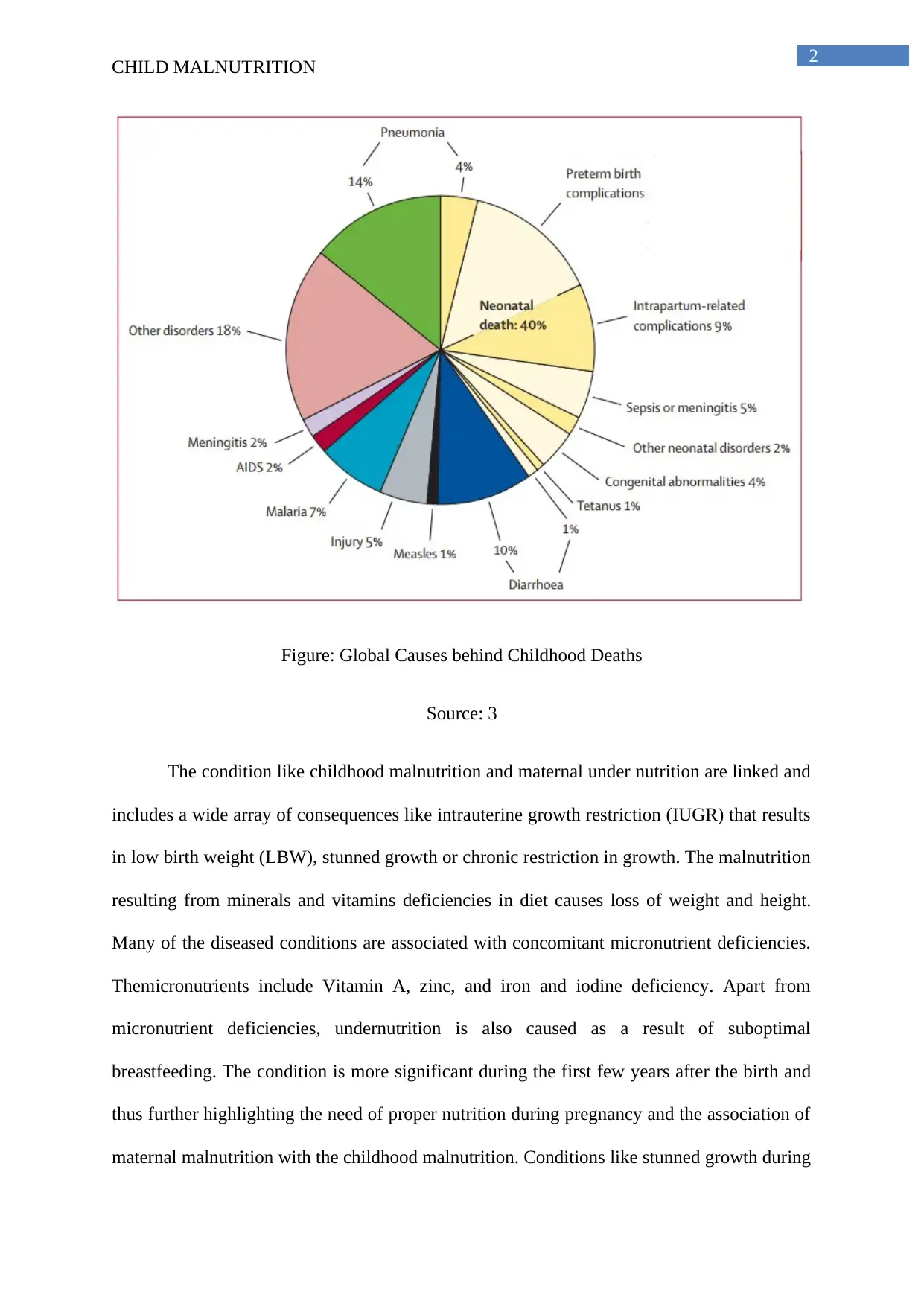
2
CHILD MALNUTRITION
Figure: Global Causes behind Childhood Deaths
Source: 3
The condition like childhood malnutrition and maternal under nutrition are linked and
includes a wide array of consequences like intrauterine growth restriction (IUGR) that results
in low birth weight (LBW), stunned growth or chronic restriction in growth. The malnutrition
resulting from minerals and vitamins deficiencies in diet causes loss of weight and height.
Many of the diseased conditions are associated with concomitant micronutrient deficiencies.
Themicronutrients include Vitamin A, zinc, and iron and iodine deficiency. Apart from
micronutrient deficiencies, undernutrition is also caused as a result of suboptimal
breastfeeding. The condition is more significant during the first few years after the birth and
thus further highlighting the need of proper nutrition during pregnancy and the association of
maternal malnutrition with the childhood malnutrition. Conditions like stunned growth during
CHILD MALNUTRITION
Figure: Global Causes behind Childhood Deaths
Source: 3
The condition like childhood malnutrition and maternal under nutrition are linked and
includes a wide array of consequences like intrauterine growth restriction (IUGR) that results
in low birth weight (LBW), stunned growth or chronic restriction in growth. The malnutrition
resulting from minerals and vitamins deficiencies in diet causes loss of weight and height.
Many of the diseased conditions are associated with concomitant micronutrient deficiencies.
Themicronutrients include Vitamin A, zinc, and iron and iodine deficiency. Apart from
micronutrient deficiencies, undernutrition is also caused as a result of suboptimal
breastfeeding. The condition is more significant during the first few years after the birth and
thus further highlighting the need of proper nutrition during pregnancy and the association of
maternal malnutrition with the childhood malnutrition. Conditions like stunned growth during
⊘ This is a preview!⊘
Do you want full access?
Subscribe today to unlock all pages.

Trusted by 1+ million students worldwide
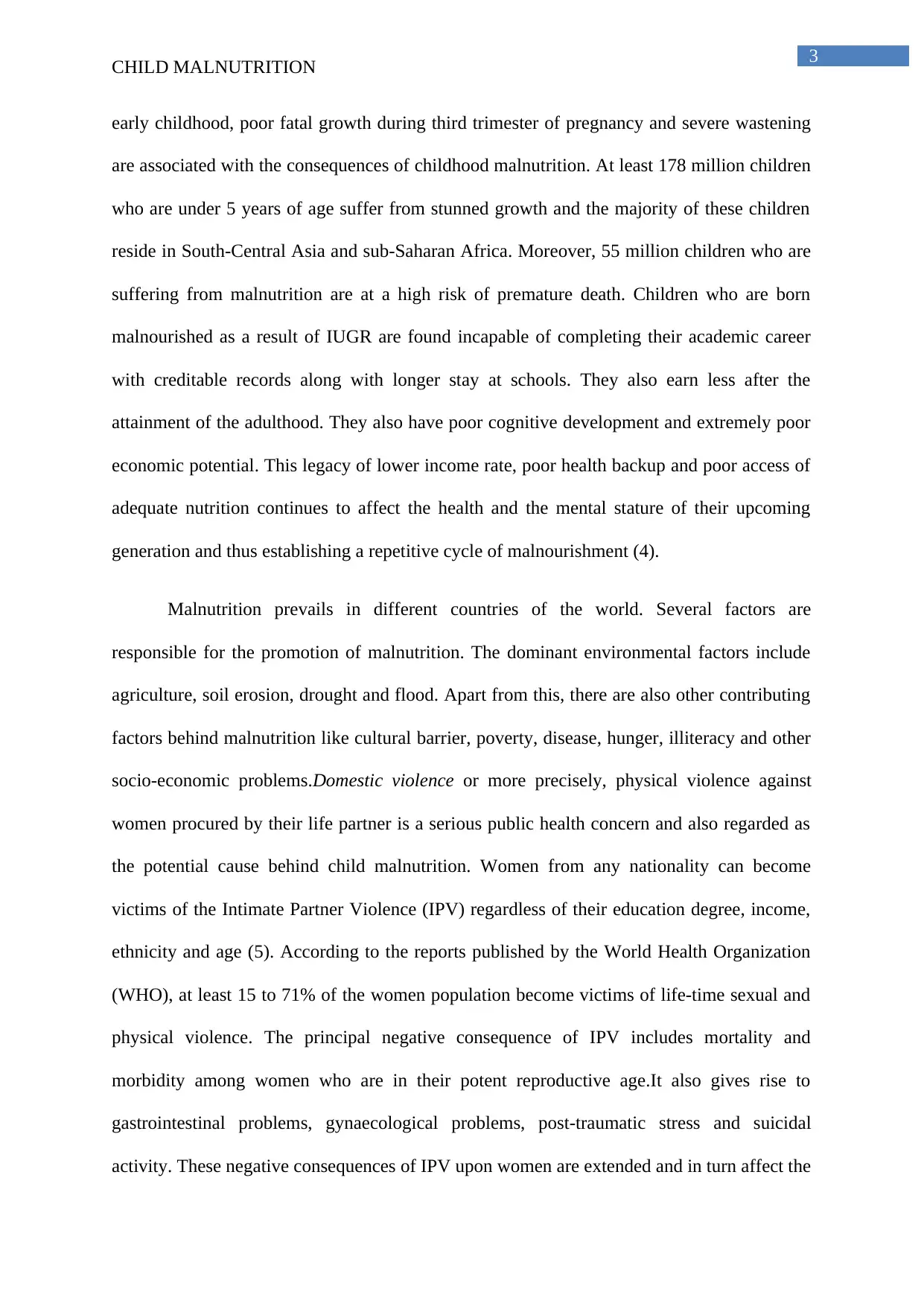
3
CHILD MALNUTRITION
early childhood, poor fatal growth during third trimester of pregnancy and severe wastening
are associated with the consequences of childhood malnutrition. At least 178 million children
who are under 5 years of age suffer from stunned growth and the majority of these children
reside in South-Central Asia and sub-Saharan Africa. Moreover, 55 million children who are
suffering from malnutrition are at a high risk of premature death. Children who are born
malnourished as a result of IUGR are found incapable of completing their academic career
with creditable records along with longer stay at schools. They also earn less after the
attainment of the adulthood. They also have poor cognitive development and extremely poor
economic potential. This legacy of lower income rate, poor health backup and poor access of
adequate nutrition continues to affect the health and the mental stature of their upcoming
generation and thus establishing a repetitive cycle of malnourishment (4).
Malnutrition prevails in different countries of the world. Several factors are
responsible for the promotion of malnutrition. The dominant environmental factors include
agriculture, soil erosion, drought and flood. Apart from this, there are also other contributing
factors behind malnutrition like cultural barrier, poverty, disease, hunger, illiteracy and other
socio-economic problems.Domestic violence or more precisely, physical violence against
women procured by their life partner is a serious public health concern and also regarded as
the potential cause behind child malnutrition. Women from any nationality can become
victims of the Intimate Partner Violence (IPV) regardless of their education degree, income,
ethnicity and age (5). According to the reports published by the World Health Organization
(WHO), at least 15 to 71% of the women population become victims of life-time sexual and
physical violence. The principal negative consequence of IPV includes mortality and
morbidity among women who are in their potent reproductive age.It also gives rise to
gastrointestinal problems, gynaecological problems, post-traumatic stress and suicidal
activity. These negative consequences of IPV upon women are extended and in turn affect the
CHILD MALNUTRITION
early childhood, poor fatal growth during third trimester of pregnancy and severe wastening
are associated with the consequences of childhood malnutrition. At least 178 million children
who are under 5 years of age suffer from stunned growth and the majority of these children
reside in South-Central Asia and sub-Saharan Africa. Moreover, 55 million children who are
suffering from malnutrition are at a high risk of premature death. Children who are born
malnourished as a result of IUGR are found incapable of completing their academic career
with creditable records along with longer stay at schools. They also earn less after the
attainment of the adulthood. They also have poor cognitive development and extremely poor
economic potential. This legacy of lower income rate, poor health backup and poor access of
adequate nutrition continues to affect the health and the mental stature of their upcoming
generation and thus establishing a repetitive cycle of malnourishment (4).
Malnutrition prevails in different countries of the world. Several factors are
responsible for the promotion of malnutrition. The dominant environmental factors include
agriculture, soil erosion, drought and flood. Apart from this, there are also other contributing
factors behind malnutrition like cultural barrier, poverty, disease, hunger, illiteracy and other
socio-economic problems.Domestic violence or more precisely, physical violence against
women procured by their life partner is a serious public health concern and also regarded as
the potential cause behind child malnutrition. Women from any nationality can become
victims of the Intimate Partner Violence (IPV) regardless of their education degree, income,
ethnicity and age (5). According to the reports published by the World Health Organization
(WHO), at least 15 to 71% of the women population become victims of life-time sexual and
physical violence. The principal negative consequence of IPV includes mortality and
morbidity among women who are in their potent reproductive age.It also gives rise to
gastrointestinal problems, gynaecological problems, post-traumatic stress and suicidal
activity. These negative consequences of IPV upon women are extended and in turn affect the
Paraphrase This Document
Need a fresh take? Get an instant paraphrase of this document with our AI Paraphraser
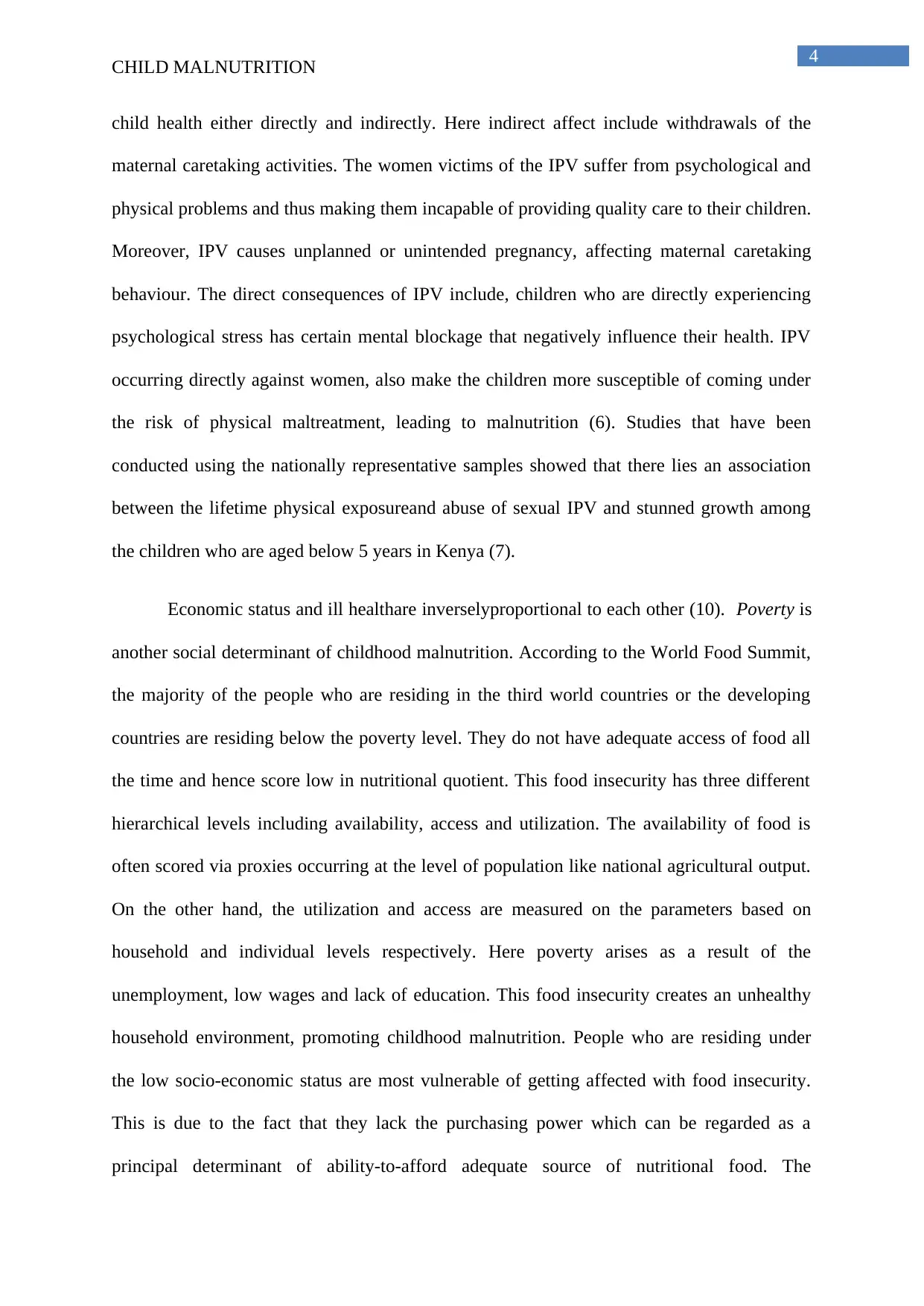
4
CHILD MALNUTRITION
child health either directly and indirectly. Here indirect affect include withdrawals of the
maternal caretaking activities. The women victims of the IPV suffer from psychological and
physical problems and thus making them incapable of providing quality care to their children.
Moreover, IPV causes unplanned or unintended pregnancy, affecting maternal caretaking
behaviour. The direct consequences of IPV include, children who are directly experiencing
psychological stress has certain mental blockage that negatively influence their health. IPV
occurring directly against women, also make the children more susceptible of coming under
the risk of physical maltreatment, leading to malnutrition (6). Studies that have been
conducted using the nationally representative samples showed that there lies an association
between the lifetime physical exposureand abuse of sexual IPV and stunned growth among
the children who are aged below 5 years in Kenya (7).
Economic status and ill healthare inverselyproportional to each other (10). Poverty is
another social determinant of childhood malnutrition. According to the World Food Summit,
the majority of the people who are residing in the third world countries or the developing
countries are residing below the poverty level. They do not have adequate access of food all
the time and hence score low in nutritional quotient. This food insecurity has three different
hierarchical levels including availability, access and utilization. The availability of food is
often scored via proxies occurring at the level of population like national agricultural output.
On the other hand, the utilization and access are measured on the parameters based on
household and individual levels respectively. Here poverty arises as a result of the
unemployment, low wages and lack of education. This food insecurity creates an unhealthy
household environment, promoting childhood malnutrition. People who are residing under
the low socio-economic status are most vulnerable of getting affected with food insecurity.
This is due to the fact that they lack the purchasing power which can be regarded as a
principal determinant of ability-to-afford adequate source of nutritional food. The
CHILD MALNUTRITION
child health either directly and indirectly. Here indirect affect include withdrawals of the
maternal caretaking activities. The women victims of the IPV suffer from psychological and
physical problems and thus making them incapable of providing quality care to their children.
Moreover, IPV causes unplanned or unintended pregnancy, affecting maternal caretaking
behaviour. The direct consequences of IPV include, children who are directly experiencing
psychological stress has certain mental blockage that negatively influence their health. IPV
occurring directly against women, also make the children more susceptible of coming under
the risk of physical maltreatment, leading to malnutrition (6). Studies that have been
conducted using the nationally representative samples showed that there lies an association
between the lifetime physical exposureand abuse of sexual IPV and stunned growth among
the children who are aged below 5 years in Kenya (7).
Economic status and ill healthare inverselyproportional to each other (10). Poverty is
another social determinant of childhood malnutrition. According to the World Food Summit,
the majority of the people who are residing in the third world countries or the developing
countries are residing below the poverty level. They do not have adequate access of food all
the time and hence score low in nutritional quotient. This food insecurity has three different
hierarchical levels including availability, access and utilization. The availability of food is
often scored via proxies occurring at the level of population like national agricultural output.
On the other hand, the utilization and access are measured on the parameters based on
household and individual levels respectively. Here poverty arises as a result of the
unemployment, low wages and lack of education. This food insecurity creates an unhealthy
household environment, promoting childhood malnutrition. People who are residing under
the low socio-economic status are most vulnerable of getting affected with food insecurity.
This is due to the fact that they lack the purchasing power which can be regarded as a
principal determinant of ability-to-afford adequate source of nutritional food. The
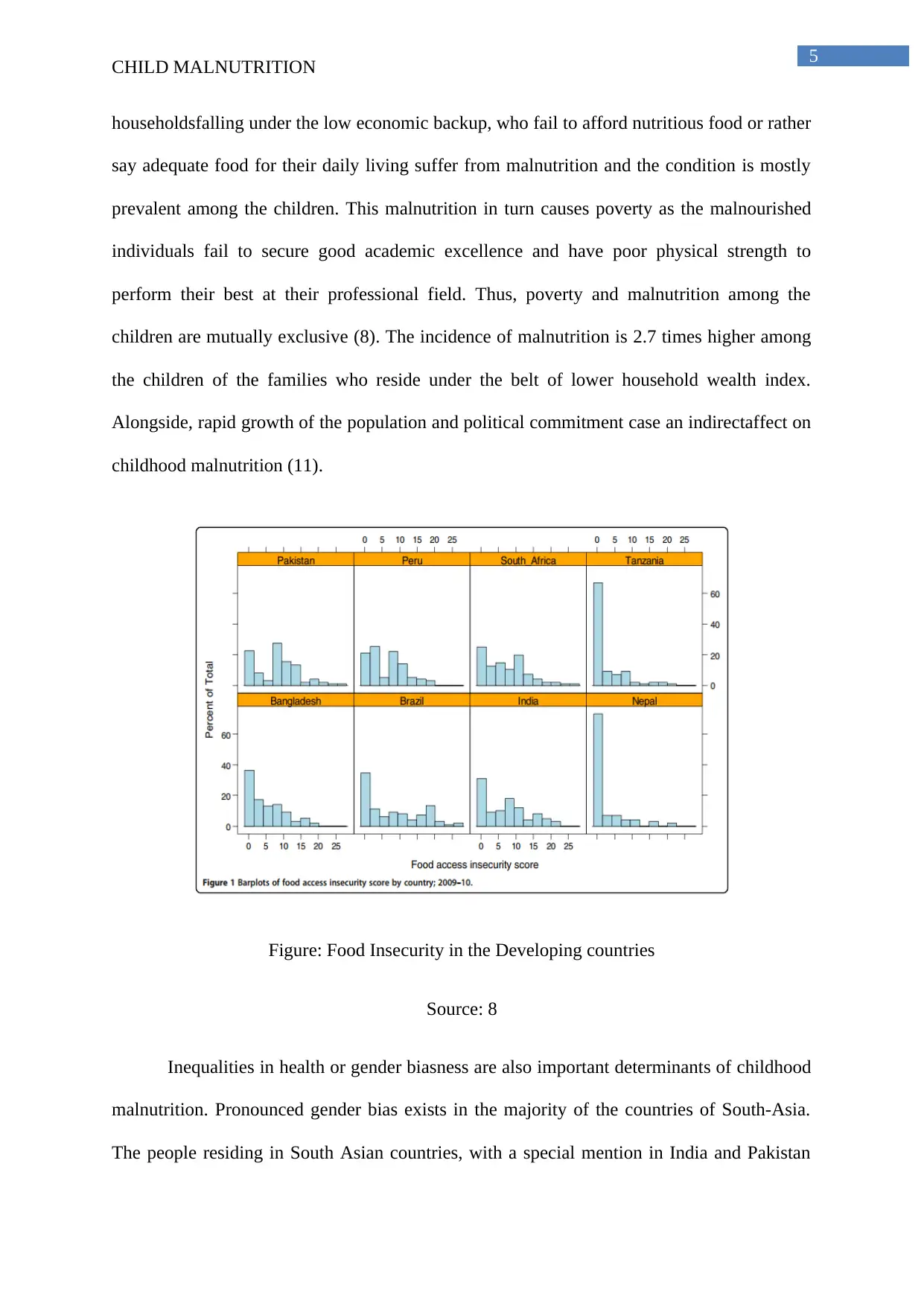
5
CHILD MALNUTRITION
householdsfalling under the low economic backup, who fail to afford nutritious food or rather
say adequate food for their daily living suffer from malnutrition and the condition is mostly
prevalent among the children. This malnutrition in turn causes poverty as the malnourished
individuals fail to secure good academic excellence and have poor physical strength to
perform their best at their professional field. Thus, poverty and malnutrition among the
children are mutually exclusive (8). The incidence of malnutrition is 2.7 times higher among
the children of the families who reside under the belt of lower household wealth index.
Alongside, rapid growth of the population and political commitment case an indirectaffect on
childhood malnutrition (11).
Figure: Food Insecurity in the Developing countries
Source: 8
Inequalities in health or gender biasness are also important determinants of childhood
malnutrition. Pronounced gender bias exists in the majority of the countries of South-Asia.
The people residing in South Asian countries, with a special mention in India and Pakistan
CHILD MALNUTRITION
householdsfalling under the low economic backup, who fail to afford nutritious food or rather
say adequate food for their daily living suffer from malnutrition and the condition is mostly
prevalent among the children. This malnutrition in turn causes poverty as the malnourished
individuals fail to secure good academic excellence and have poor physical strength to
perform their best at their professional field. Thus, poverty and malnutrition among the
children are mutually exclusive (8). The incidence of malnutrition is 2.7 times higher among
the children of the families who reside under the belt of lower household wealth index.
Alongside, rapid growth of the population and political commitment case an indirectaffect on
childhood malnutrition (11).
Figure: Food Insecurity in the Developing countries
Source: 8
Inequalities in health or gender biasness are also important determinants of childhood
malnutrition. Pronounced gender bias exists in the majority of the countries of South-Asia.
The people residing in South Asian countries, with a special mention in India and Pakistan
⊘ This is a preview!⊘
Do you want full access?
Subscribe today to unlock all pages.

Trusted by 1+ million students worldwide
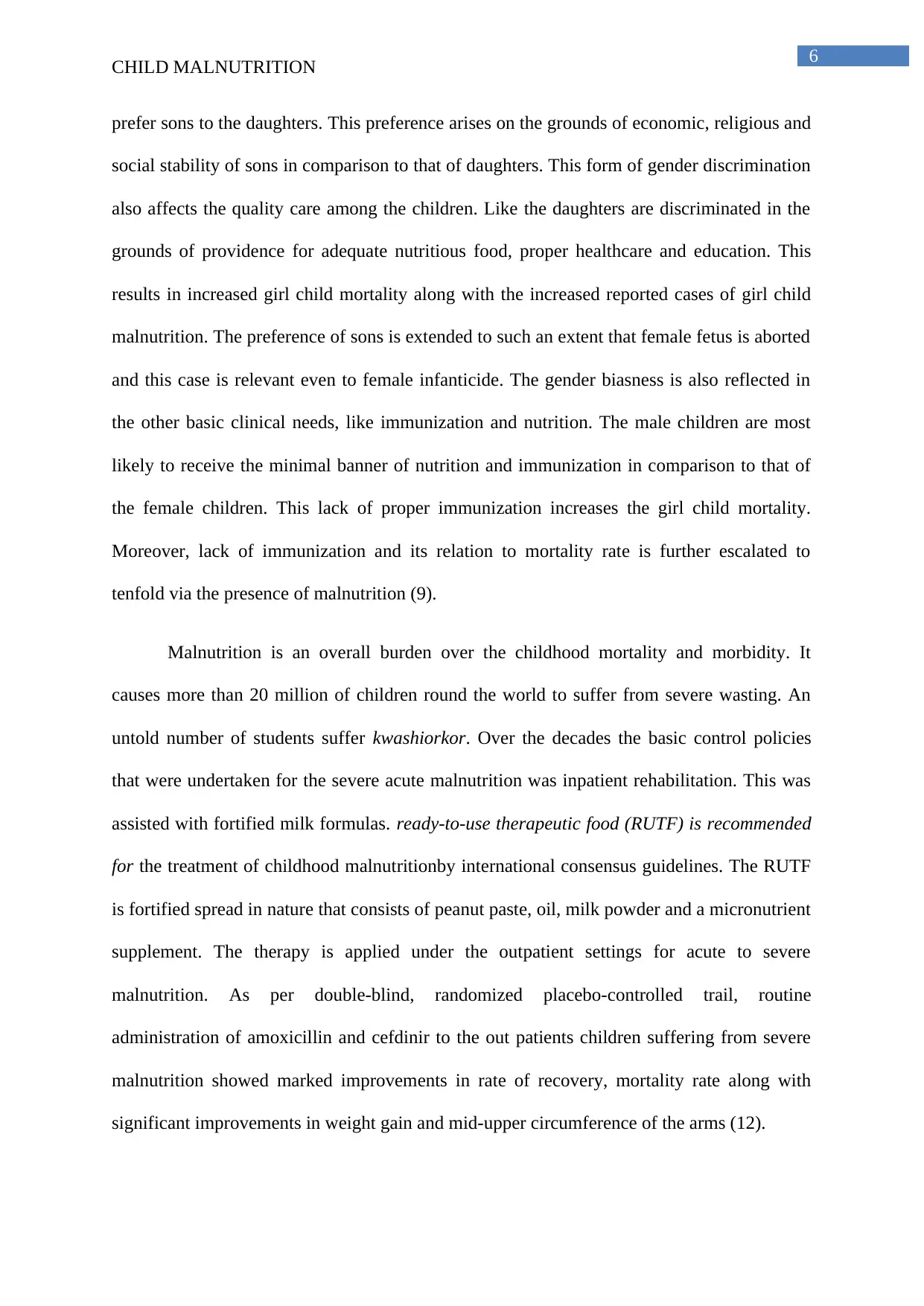
6
CHILD MALNUTRITION
prefer sons to the daughters. This preference arises on the grounds of economic, religious and
social stability of sons in comparison to that of daughters. This form of gender discrimination
also affects the quality care among the children. Like the daughters are discriminated in the
grounds of providence for adequate nutritious food, proper healthcare and education. This
results in increased girl child mortality along with the increased reported cases of girl child
malnutrition. The preference of sons is extended to such an extent that female fetus is aborted
and this case is relevant even to female infanticide. The gender biasness is also reflected in
the other basic clinical needs, like immunization and nutrition. The male children are most
likely to receive the minimal banner of nutrition and immunization in comparison to that of
the female children. This lack of proper immunization increases the girl child mortality.
Moreover, lack of immunization and its relation to mortality rate is further escalated to
tenfold via the presence of malnutrition (9).
Malnutrition is an overall burden over the childhood mortality and morbidity. It
causes more than 20 million of children round the world to suffer from severe wasting. An
untold number of students suffer kwashiorkor. Over the decades the basic control policies
that were undertaken for the severe acute malnutrition was inpatient rehabilitation. This was
assisted with fortified milk formulas. ready-to-use therapeutic food (RUTF) is recommended
for the treatment of childhood malnutritionby international consensus guidelines. The RUTF
is fortified spread in nature that consists of peanut paste, oil, milk powder and a micronutrient
supplement. The therapy is applied under the outpatient settings for acute to severe
malnutrition. As per double-blind, randomized placebo-controlled trail, routine
administration of amoxicillin and cefdinir to the out patients children suffering from severe
malnutrition showed marked improvements in rate of recovery, mortality rate along with
significant improvements in weight gain and mid-upper circumference of the arms (12).
CHILD MALNUTRITION
prefer sons to the daughters. This preference arises on the grounds of economic, religious and
social stability of sons in comparison to that of daughters. This form of gender discrimination
also affects the quality care among the children. Like the daughters are discriminated in the
grounds of providence for adequate nutritious food, proper healthcare and education. This
results in increased girl child mortality along with the increased reported cases of girl child
malnutrition. The preference of sons is extended to such an extent that female fetus is aborted
and this case is relevant even to female infanticide. The gender biasness is also reflected in
the other basic clinical needs, like immunization and nutrition. The male children are most
likely to receive the minimal banner of nutrition and immunization in comparison to that of
the female children. This lack of proper immunization increases the girl child mortality.
Moreover, lack of immunization and its relation to mortality rate is further escalated to
tenfold via the presence of malnutrition (9).
Malnutrition is an overall burden over the childhood mortality and morbidity. It
causes more than 20 million of children round the world to suffer from severe wasting. An
untold number of students suffer kwashiorkor. Over the decades the basic control policies
that were undertaken for the severe acute malnutrition was inpatient rehabilitation. This was
assisted with fortified milk formulas. ready-to-use therapeutic food (RUTF) is recommended
for the treatment of childhood malnutritionby international consensus guidelines. The RUTF
is fortified spread in nature that consists of peanut paste, oil, milk powder and a micronutrient
supplement. The therapy is applied under the outpatient settings for acute to severe
malnutrition. As per double-blind, randomized placebo-controlled trail, routine
administration of amoxicillin and cefdinir to the out patients children suffering from severe
malnutrition showed marked improvements in rate of recovery, mortality rate along with
significant improvements in weight gain and mid-upper circumference of the arms (12).
Paraphrase This Document
Need a fresh take? Get an instant paraphrase of this document with our AI Paraphraser
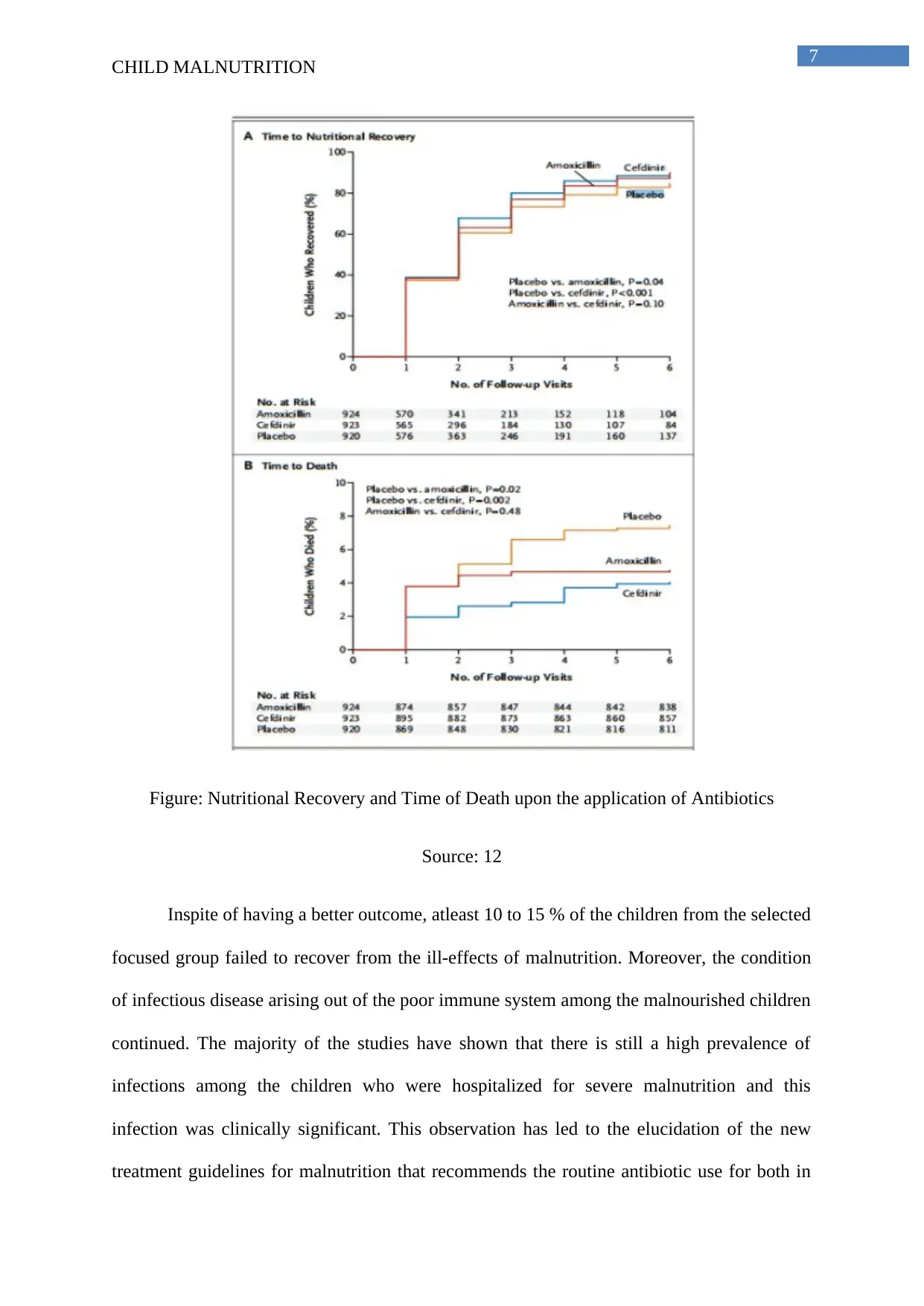
7
CHILD MALNUTRITION
Figure: Nutritional Recovery and Time of Death upon the application of Antibiotics
Source: 12
Inspite of having a better outcome, atleast 10 to 15 % of the children from the selected
focused group failed to recover from the ill-effects of malnutrition. Moreover, the condition
of infectious disease arising out of the poor immune system among the malnourished children
continued. The majority of the studies have shown that there is still a high prevalence of
infections among the children who were hospitalized for severe malnutrition and this
infection was clinically significant. This observation has led to the elucidation of the new
treatment guidelines for malnutrition that recommends the routine antibiotic use for both in
CHILD MALNUTRITION
Figure: Nutritional Recovery and Time of Death upon the application of Antibiotics
Source: 12
Inspite of having a better outcome, atleast 10 to 15 % of the children from the selected
focused group failed to recover from the ill-effects of malnutrition. Moreover, the condition
of infectious disease arising out of the poor immune system among the malnourished children
continued. The majority of the studies have shown that there is still a high prevalence of
infections among the children who were hospitalized for severe malnutrition and this
infection was clinically significant. This observation has led to the elucidation of the new
treatment guidelines for malnutrition that recommends the routine antibiotic use for both in
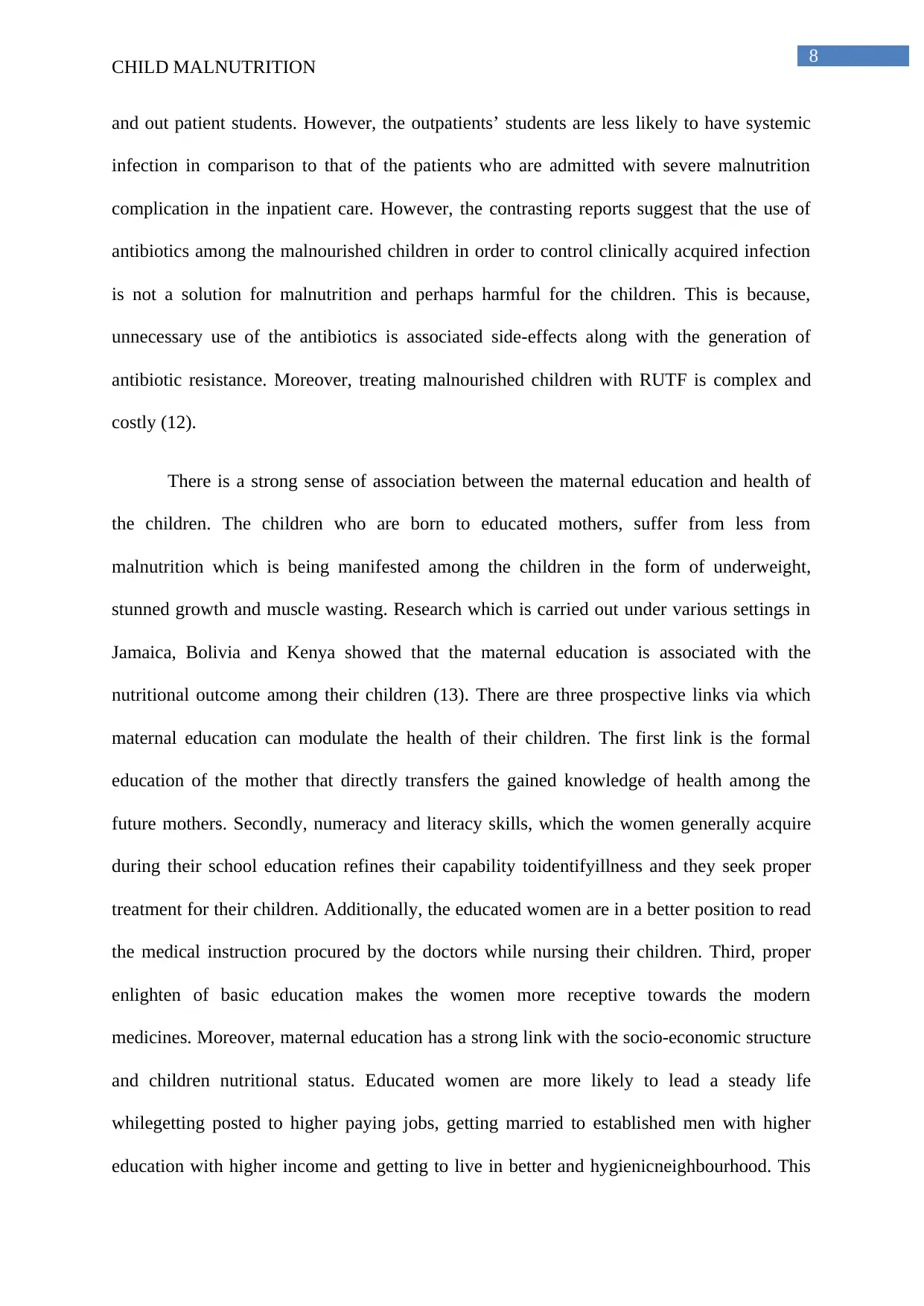
8
CHILD MALNUTRITION
and out patient students. However, the outpatients’ students are less likely to have systemic
infection in comparison to that of the patients who are admitted with severe malnutrition
complication in the inpatient care. However, the contrasting reports suggest that the use of
antibiotics among the malnourished children in order to control clinically acquired infection
is not a solution for malnutrition and perhaps harmful for the children. This is because,
unnecessary use of the antibiotics is associated side-effects along with the generation of
antibiotic resistance. Moreover, treating malnourished children with RUTF is complex and
costly (12).
There is a strong sense of association between the maternal education and health of
the children. The children who are born to educated mothers, suffer from less from
malnutrition which is being manifested among the children in the form of underweight,
stunned growth and muscle wasting. Research which is carried out under various settings in
Jamaica, Bolivia and Kenya showed that the maternal education is associated with the
nutritional outcome among their children (13). There are three prospective links via which
maternal education can modulate the health of their children. The first link is the formal
education of the mother that directly transfers the gained knowledge of health among the
future mothers. Secondly, numeracy and literacy skills, which the women generally acquire
during their school education refines their capability toidentifyillness and they seek proper
treatment for their children. Additionally, the educated women are in a better position to read
the medical instruction procured by the doctors while nursing their children. Third, proper
enlighten of basic education makes the women more receptive towards the modern
medicines. Moreover, maternal education has a strong link with the socio-economic structure
and children nutritional status. Educated women are more likely to lead a steady life
whilegetting posted to higher paying jobs, getting married to established men with higher
education with higher income and getting to live in better and hygienicneighbourhood. This
CHILD MALNUTRITION
and out patient students. However, the outpatients’ students are less likely to have systemic
infection in comparison to that of the patients who are admitted with severe malnutrition
complication in the inpatient care. However, the contrasting reports suggest that the use of
antibiotics among the malnourished children in order to control clinically acquired infection
is not a solution for malnutrition and perhaps harmful for the children. This is because,
unnecessary use of the antibiotics is associated side-effects along with the generation of
antibiotic resistance. Moreover, treating malnourished children with RUTF is complex and
costly (12).
There is a strong sense of association between the maternal education and health of
the children. The children who are born to educated mothers, suffer from less from
malnutrition which is being manifested among the children in the form of underweight,
stunned growth and muscle wasting. Research which is carried out under various settings in
Jamaica, Bolivia and Kenya showed that the maternal education is associated with the
nutritional outcome among their children (13). There are three prospective links via which
maternal education can modulate the health of their children. The first link is the formal
education of the mother that directly transfers the gained knowledge of health among the
future mothers. Secondly, numeracy and literacy skills, which the women generally acquire
during their school education refines their capability toidentifyillness and they seek proper
treatment for their children. Additionally, the educated women are in a better position to read
the medical instruction procured by the doctors while nursing their children. Third, proper
enlighten of basic education makes the women more receptive towards the modern
medicines. Moreover, maternal education has a strong link with the socio-economic structure
and children nutritional status. Educated women are more likely to lead a steady life
whilegetting posted to higher paying jobs, getting married to established men with higher
education with higher income and getting to live in better and hygienicneighbourhood. This
⊘ This is a preview!⊘
Do you want full access?
Subscribe today to unlock all pages.

Trusted by 1+ million students worldwide
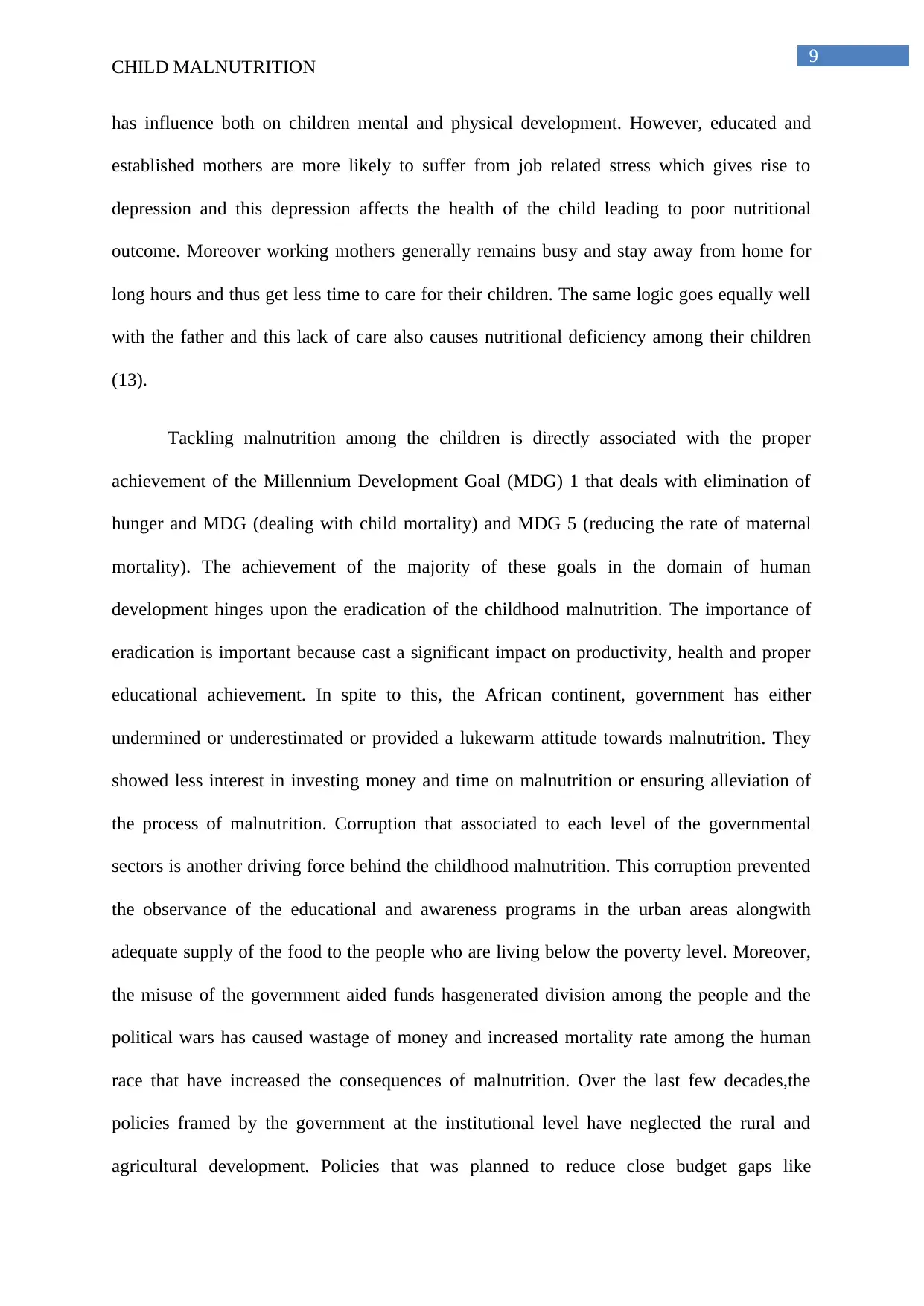
9
CHILD MALNUTRITION
has influence both on children mental and physical development. However, educated and
established mothers are more likely to suffer from job related stress which gives rise to
depression and this depression affects the health of the child leading to poor nutritional
outcome. Moreover working mothers generally remains busy and stay away from home for
long hours and thus get less time to care for their children. The same logic goes equally well
with the father and this lack of care also causes nutritional deficiency among their children
(13).
Tackling malnutrition among the children is directly associated with the proper
achievement of the Millennium Development Goal (MDG) 1 that deals with elimination of
hunger and MDG (dealing with child mortality) and MDG 5 (reducing the rate of maternal
mortality). The achievement of the majority of these goals in the domain of human
development hinges upon the eradication of the childhood malnutrition. The importance of
eradication is important because cast a significant impact on productivity, health and proper
educational achievement. In spite to this, the African continent, government has either
undermined or underestimated or provided a lukewarm attitude towards malnutrition. They
showed less interest in investing money and time on malnutrition or ensuring alleviation of
the process of malnutrition. Corruption that associated to each level of the governmental
sectors is another driving force behind the childhood malnutrition. This corruption prevented
the observance of the educational and awareness programs in the urban areas alongwith
adequate supply of the food to the people who are living below the poverty level. Moreover,
the misuse of the government aided funds hasgenerated division among the people and the
political wars has caused wastage of money and increased mortality rate among the human
race that have increased the consequences of malnutrition. Over the last few decades,the
policies framed by the government at the institutional level have neglected the rural and
agricultural development. Policies that was planned to reduce close budget gaps like
CHILD MALNUTRITION
has influence both on children mental and physical development. However, educated and
established mothers are more likely to suffer from job related stress which gives rise to
depression and this depression affects the health of the child leading to poor nutritional
outcome. Moreover working mothers generally remains busy and stay away from home for
long hours and thus get less time to care for their children. The same logic goes equally well
with the father and this lack of care also causes nutritional deficiency among their children
(13).
Tackling malnutrition among the children is directly associated with the proper
achievement of the Millennium Development Goal (MDG) 1 that deals with elimination of
hunger and MDG (dealing with child mortality) and MDG 5 (reducing the rate of maternal
mortality). The achievement of the majority of these goals in the domain of human
development hinges upon the eradication of the childhood malnutrition. The importance of
eradication is important because cast a significant impact on productivity, health and proper
educational achievement. In spite to this, the African continent, government has either
undermined or underestimated or provided a lukewarm attitude towards malnutrition. They
showed less interest in investing money and time on malnutrition or ensuring alleviation of
the process of malnutrition. Corruption that associated to each level of the governmental
sectors is another driving force behind the childhood malnutrition. This corruption prevented
the observance of the educational and awareness programs in the urban areas alongwith
adequate supply of the food to the people who are living below the poverty level. Moreover,
the misuse of the government aided funds hasgenerated division among the people and the
political wars has caused wastage of money and increased mortality rate among the human
race that have increased the consequences of malnutrition. Over the last few decades,the
policies framed by the government at the institutional level have neglected the rural and
agricultural development. Policies that was planned to reduce close budget gaps like
Paraphrase This Document
Need a fresh take? Get an instant paraphrase of this document with our AI Paraphraser
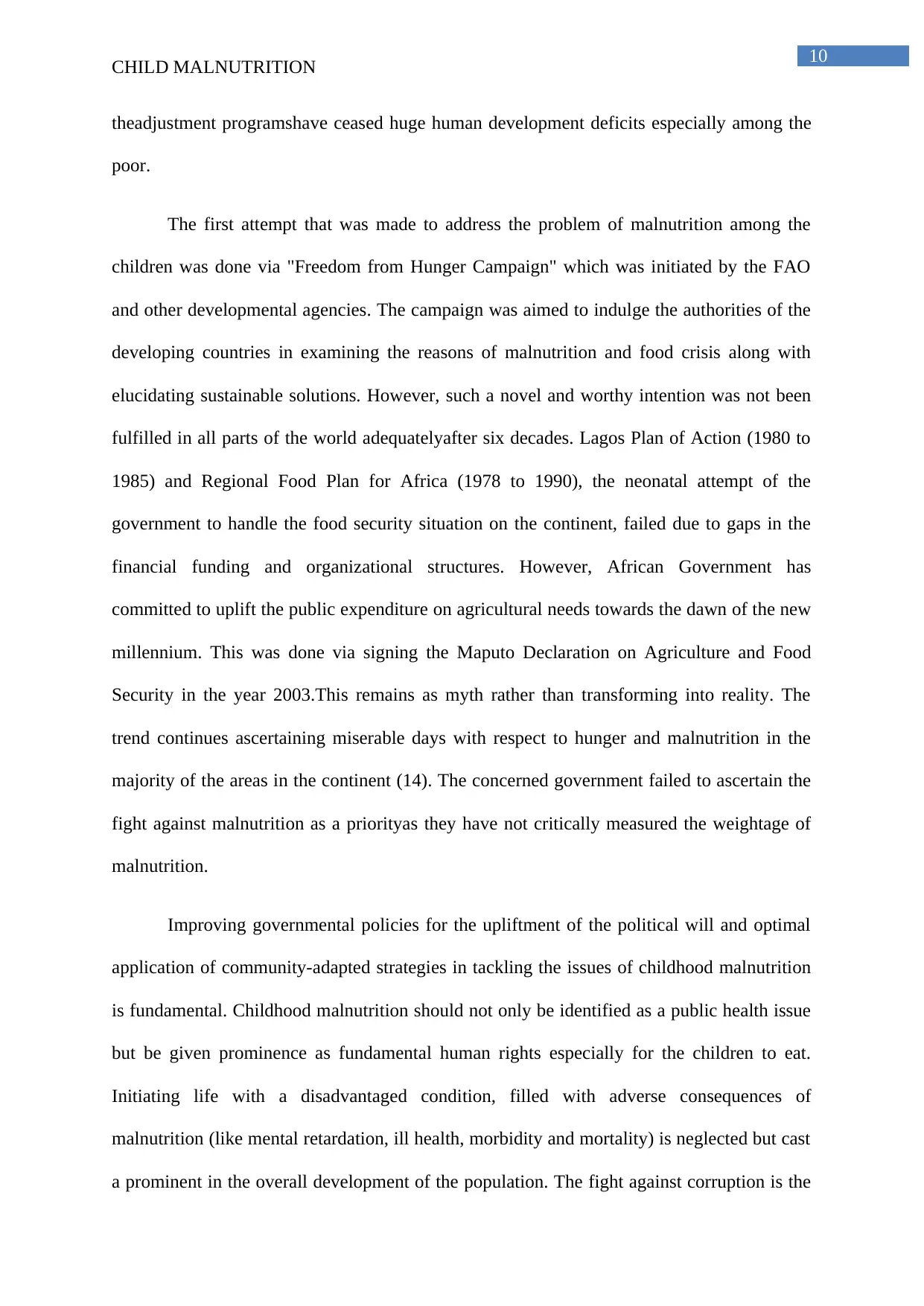
10
CHILD MALNUTRITION
theadjustment programshave ceased huge human development deficits especially among the
poor.
The first attempt that was made to address the problem of malnutrition among the
children was done via "Freedom from Hunger Campaign" which was initiated by the FAO
and other developmental agencies. The campaign was aimed to indulge the authorities of the
developing countries in examining the reasons of malnutrition and food crisis along with
elucidating sustainable solutions. However, such a novel and worthy intention was not been
fulfilled in all parts of the world adequatelyafter six decades. Lagos Plan of Action (1980 to
1985) and Regional Food Plan for Africa (1978 to 1990), the neonatal attempt of the
government to handle the food security situation on the continent, failed due to gaps in the
financial funding and organizational structures. However, African Government has
committed to uplift the public expenditure on agricultural needs towards the dawn of the new
millennium. This was done via signing the Maputo Declaration on Agriculture and Food
Security in the year 2003.This remains as myth rather than transforming into reality. The
trend continues ascertaining miserable days with respect to hunger and malnutrition in the
majority of the areas in the continent (14). The concerned government failed to ascertain the
fight against malnutrition as a priorityas they have not critically measured the weightage of
malnutrition.
Improving governmental policies for the upliftment of the political will and optimal
application of community-adapted strategies in tackling the issues of childhood malnutrition
is fundamental. Childhood malnutrition should not only be identified as a public health issue
but be given prominence as fundamental human rights especially for the children to eat.
Initiating life with a disadvantaged condition, filled with adverse consequences of
malnutrition (like mental retardation, ill health, morbidity and mortality) is neglected but cast
a prominent in the overall development of the population. The fight against corruption is the
CHILD MALNUTRITION
theadjustment programshave ceased huge human development deficits especially among the
poor.
The first attempt that was made to address the problem of malnutrition among the
children was done via "Freedom from Hunger Campaign" which was initiated by the FAO
and other developmental agencies. The campaign was aimed to indulge the authorities of the
developing countries in examining the reasons of malnutrition and food crisis along with
elucidating sustainable solutions. However, such a novel and worthy intention was not been
fulfilled in all parts of the world adequatelyafter six decades. Lagos Plan of Action (1980 to
1985) and Regional Food Plan for Africa (1978 to 1990), the neonatal attempt of the
government to handle the food security situation on the continent, failed due to gaps in the
financial funding and organizational structures. However, African Government has
committed to uplift the public expenditure on agricultural needs towards the dawn of the new
millennium. This was done via signing the Maputo Declaration on Agriculture and Food
Security in the year 2003.This remains as myth rather than transforming into reality. The
trend continues ascertaining miserable days with respect to hunger and malnutrition in the
majority of the areas in the continent (14). The concerned government failed to ascertain the
fight against malnutrition as a priorityas they have not critically measured the weightage of
malnutrition.
Improving governmental policies for the upliftment of the political will and optimal
application of community-adapted strategies in tackling the issues of childhood malnutrition
is fundamental. Childhood malnutrition should not only be identified as a public health issue
but be given prominence as fundamental human rights especially for the children to eat.
Initiating life with a disadvantaged condition, filled with adverse consequences of
malnutrition (like mental retardation, ill health, morbidity and mortality) is neglected but cast
a prominent in the overall development of the population. The fight against corruption is the
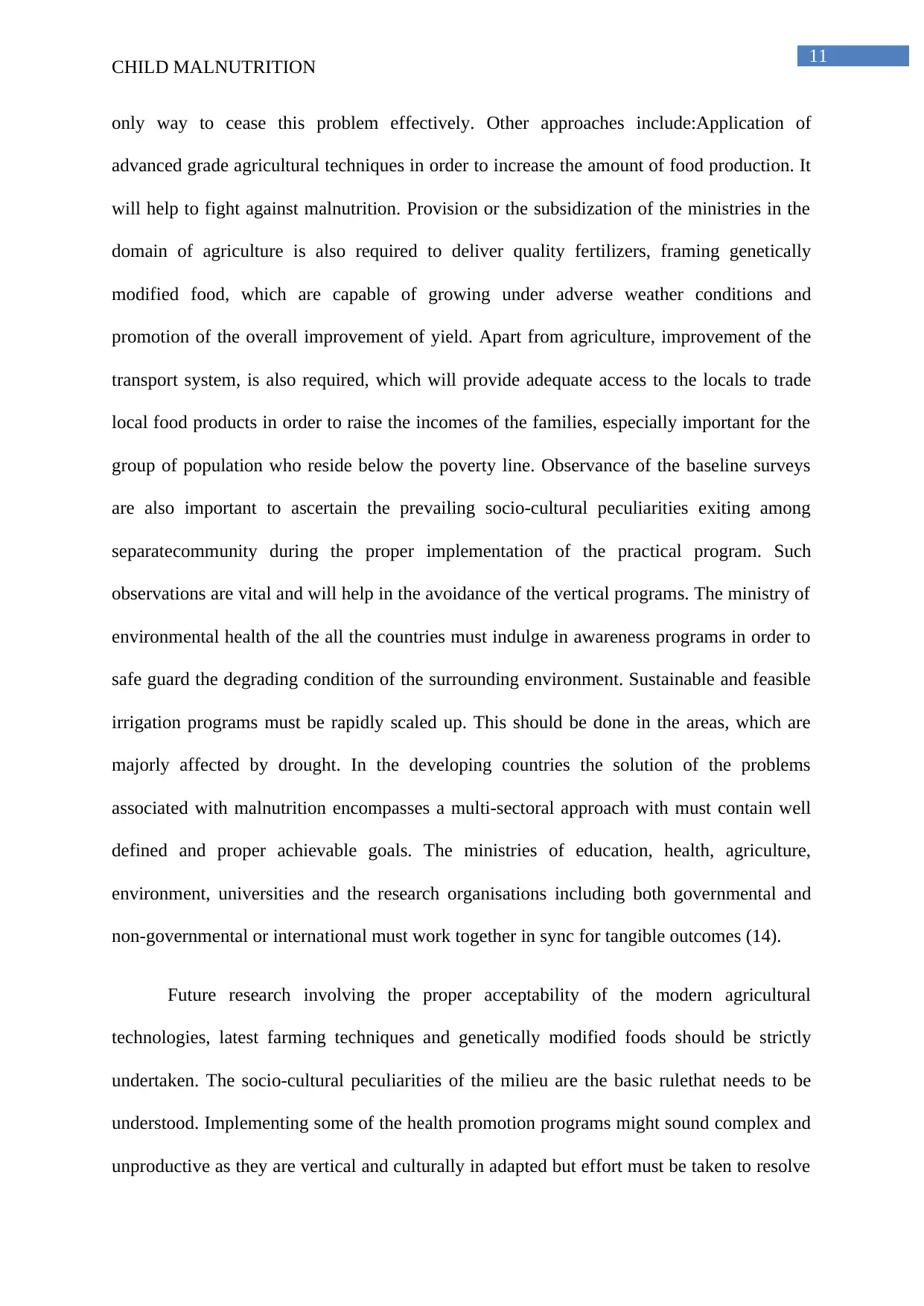
11
CHILD MALNUTRITION
only way to cease this problem effectively. Other approaches include:Application of
advanced grade agricultural techniques in order to increase the amount of food production. It
will help to fight against malnutrition. Provision or the subsidization of the ministries in the
domain of agriculture is also required to deliver quality fertilizers, framing genetically
modified food, which are capable of growing under adverse weather conditions and
promotion of the overall improvement of yield. Apart from agriculture, improvement of the
transport system, is also required, which will provide adequate access to the locals to trade
local food products in order to raise the incomes of the families, especially important for the
group of population who reside below the poverty line. Observance of the baseline surveys
are also important to ascertain the prevailing socio-cultural peculiarities exiting among
separatecommunity during the proper implementation of the practical program. Such
observations are vital and will help in the avoidance of the vertical programs. The ministry of
environmental health of the all the countries must indulge in awareness programs in order to
safe guard the degrading condition of the surrounding environment. Sustainable and feasible
irrigation programs must be rapidly scaled up. This should be done in the areas, which are
majorly affected by drought. In the developing countries the solution of the problems
associated with malnutrition encompasses a multi-sectoral approach with must contain well
defined and proper achievable goals. The ministries of education, health, agriculture,
environment, universities and the research organisations including both governmental and
non-governmental or international must work together in sync for tangible outcomes (14).
Future research involving the proper acceptability of the modern agricultural
technologies, latest farming techniques and genetically modified foods should be strictly
undertaken. The socio-cultural peculiarities of the milieu are the basic rulethat needs to be
understood. Implementing some of the health promotion programs might sound complex and
unproductive as they are vertical and culturally in adapted but effort must be taken to resolve
CHILD MALNUTRITION
only way to cease this problem effectively. Other approaches include:Application of
advanced grade agricultural techniques in order to increase the amount of food production. It
will help to fight against malnutrition. Provision or the subsidization of the ministries in the
domain of agriculture is also required to deliver quality fertilizers, framing genetically
modified food, which are capable of growing under adverse weather conditions and
promotion of the overall improvement of yield. Apart from agriculture, improvement of the
transport system, is also required, which will provide adequate access to the locals to trade
local food products in order to raise the incomes of the families, especially important for the
group of population who reside below the poverty line. Observance of the baseline surveys
are also important to ascertain the prevailing socio-cultural peculiarities exiting among
separatecommunity during the proper implementation of the practical program. Such
observations are vital and will help in the avoidance of the vertical programs. The ministry of
environmental health of the all the countries must indulge in awareness programs in order to
safe guard the degrading condition of the surrounding environment. Sustainable and feasible
irrigation programs must be rapidly scaled up. This should be done in the areas, which are
majorly affected by drought. In the developing countries the solution of the problems
associated with malnutrition encompasses a multi-sectoral approach with must contain well
defined and proper achievable goals. The ministries of education, health, agriculture,
environment, universities and the research organisations including both governmental and
non-governmental or international must work together in sync for tangible outcomes (14).
Future research involving the proper acceptability of the modern agricultural
technologies, latest farming techniques and genetically modified foods should be strictly
undertaken. The socio-cultural peculiarities of the milieu are the basic rulethat needs to be
understood. Implementing some of the health promotion programs might sound complex and
unproductive as they are vertical and culturally in adapted but effort must be taken to resolve
⊘ This is a preview!⊘
Do you want full access?
Subscribe today to unlock all pages.

Trusted by 1+ million students worldwide
1 out of 15
Related Documents
Your All-in-One AI-Powered Toolkit for Academic Success.
+13062052269
info@desklib.com
Available 24*7 on WhatsApp / Email
![[object Object]](/_next/static/media/star-bottom.7253800d.svg)
Unlock your academic potential
Copyright © 2020–2025 A2Z Services. All Rights Reserved. Developed and managed by ZUCOL.




